How to win Hearthstone’s Dalaran Heist (probably)
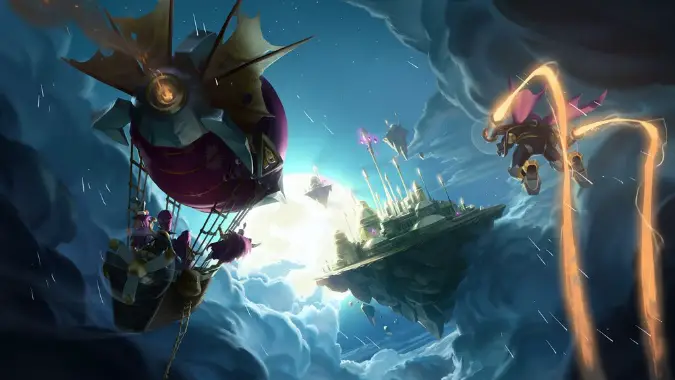
Struggling to beat Hearthstone’s Dalaran Heist single-player adventure adventure? This story mode (of a sort) sends you on an adventure through Dalaran, where you play the role of henchmen to some of Azeroth’s most notorious villains. You have the choice of one of playing any of Hearthstone’s nine classes, but with unique heroes like Captain Eudora, the Vuplera Rogue, or Kriziki, the Arakkoa Priest. Every hero — and every opponent — is fully voiced, and simply running through their chats is something of a joy.
As you venture through the city, you’ll fight your way through an array of random bosses that increase in difficulty as you go. Each area of the city offers a different “twist,” a unique challenge just for that chapter. I didn’t find these changed how I played very much, but they do give each area a bit of character.
When you defeat each boss, you get to choose new cards to add to your deck, and occasionally a treasure. As you play, you’ll unlock new hero powers and starter decks for each hero, which can really change your gameplay. Every run through Dalaran is a different experience… and it rather has to be, because if you lose, you have to start all over again.
There’s a lot of randomness to it, which either keeps the game fresh or makes it frustrating, depending on your point of view. It can be frustrating when the RNG doesn’t give you the treasures you’re looking for, but I feel that this adventure has a stronger selection of cards and treasures than previous ones. That means it’s harder to wind up with a bad deck or even a mediocre deck — though it’s still pretty easy to come up against bosses your deck just isn’t suited to dealing with.
And that makes it tough. There’s no guide that you can follow step-by-step to guarantee victory. However, knowing how to handle each chapter’s twists and each henchmen’s turns will help you find your way.
Here’s everything you need to know.
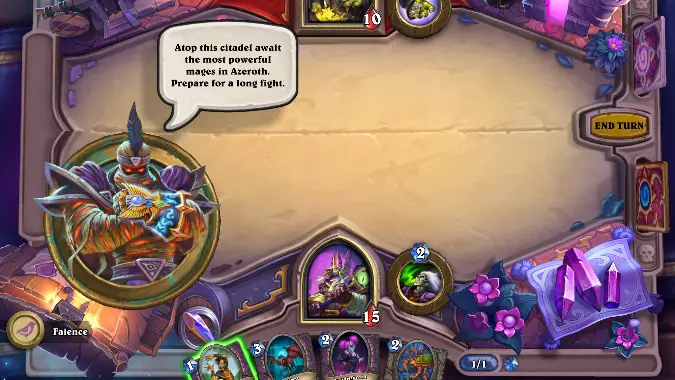
The twists
Chapter 1: Dalaran Bank
Your opponent will start the game with a 0/3 treasure chest, which gives both you and your opponent two coins. When you destroy the chest, try to use the coins right away: if you destroy the chest and simply end your turn, your opponent has an immediate 2-mana buff, while you have to wait another turn. Of course, you can completely ignore the chests, though they’re likely to break open at some point, anyway.
Chapter 2: The Violet Hold
You’re in Azeroth’s most notorious prison, so you’ll find one imprisoned minion on each side of the board. These minions can’t do anything until you’ve taken turns equal to their cost — then you get a completely free minion on the board. However, the minions are wholly random, so sometimes you’ll wind up with a fantastic minion and sometimes you’ll get a complete dud.
Chapter 3: Streets of Dalaran
Three carts take up minion slots on each side of the board, meaning you can only have four minions on the board at most. This hurts zoo decks to an extent, but doesn’t make them unplayable — and your opponent faces the same restrictions.
Chapter 4: The Underbelly
All of your minions’ attack and health is swapped. This isn’t something you can necessarily build a deck around, but if possible try to collect minions with high health. Minions with 0 attack and strong Deathrattles are great here because they will die as soon as they’re played — Goblin Bombs are my personal favorite here.
Chapter 5: Kirin Tor Citadel
This twist isn’t much of a twist: you simply fight four extra bosses to complete the run. While the first eight bosses are random as usual, the four are the same every run: Vargoth, Kalegos, and Khadgar himself. These are encounters are particularly tough, and can make this chapter a real slog.
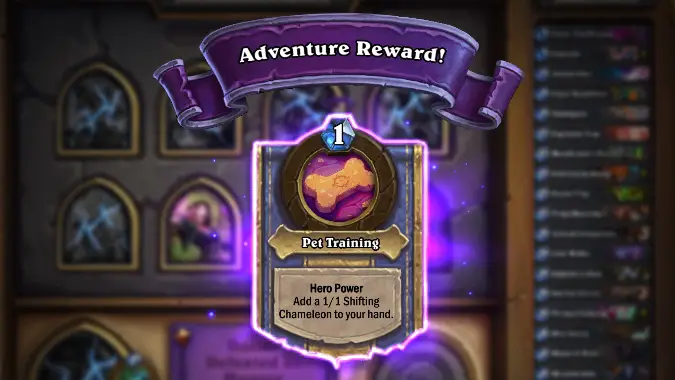
Unlocking decks and powers
When you first start your attack on Dalaran, you have the choice of at least one hero, but if you’ve bought the entire adventure you should have the standard selection of all nine classes. When you pick a class, you also get to select your hero power and then your starting deck. You’ll initially only have one hero power and one deck available to you, but you’ll unlock new ones simply by playing the game. New decks unlock when you beat a total of 5, 10, and 15 bosses with your hero of choice, while new hero powers unlock by doing various things in game, depending on your class and the deck. You may have to play 10 Deathrattle minions or restore 30 health, for example.
Frankly, I don’t think deck selection matters very much. While each deck leans towards a different playstyle, you only start with 10 cards. How you build out that deck is a lot more important than the deck you start with, plus you can make (limited) edits to your deck in the tavern encounter. So pick any deck that interests you and jump into the game — as you go, you’ll be able to customize it a little more each round.
Hero powers, however, do have a big impact on your game, so we’ll talk about them next.
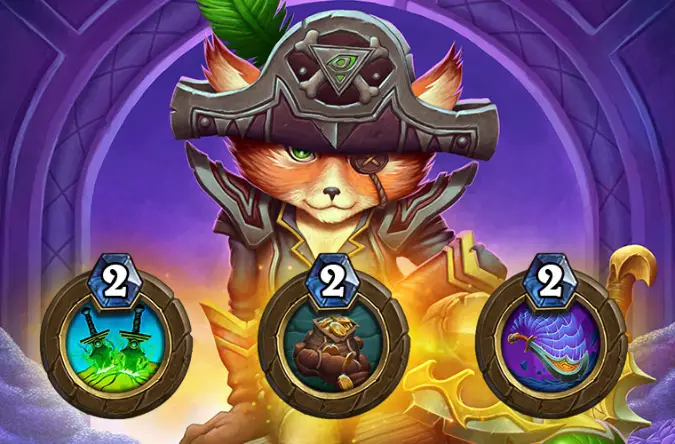
The henchmen
Mage: Rakanishu
Rating: A+
Hero Powers:
- Firebolt (2): Deals 1 damage to a target. The default Mage Hero Power, this is versatile and provides some value in any situation. It can take out early minions and chip away at health pools.
- Our pick: Burning Wit (1): Reduces the cost of a random card in your hand by 2. Spending one mana for a two mana discount is a good deal that can let you get your more powerful cards down quicker. It can be particularly powerful when paired with the Scepter of Summoning treasure, which makes any minions that cost over 5 mana to cost 5 mana. This combo can let you get huge minions out on turn 3.
- Frostburn (2), freeze a character or deal 2 damage to a frozen character. This is situational: it’s a more powerful version of Firebolt if you have a deck with lots of spells that freeze, but you may not get those card choices. This power works best in defensive decks because of its ability to slow down your opponent.
Shaman: Vessina
Rating: C
Hero Powers:
- Totemic Call (2): Summons a random totem. Though it’s the default Shaman Hero Power, Totemic Call is sometimes still the best option. While its randomness isn’t always helpful, it’s a versatile ability that provides something useful at any stage of the game. On top of that, some cards will trigger off your totems, making this a must for certain kinds of decks.
- Evolution (2): Transform a friendly minion into one that costs one more. This sounds great, but in practice it’s very slow. Think about it: let’s say you play a 1-mana minion on turn one. Then you evolve it to a (still weak) 2-mana minion on turn two. Then you evolve it to a (still weak) 3-mana minion on turn three… You get the idea. If you do take this power, bear in mind that you can’t attack with a minion after you evolve it: attack first, then evolve.
- Our Pick: Refresh (1): Draw a card, Overload 1. Essentially, you’re paying 2 mana — one now and one later — to draw a card, which is a decent value. This power has a great synergy with the many Shaman cards that trigger off Overload, but bear in mind that Refresh won’t always trigger Overload cards. Some cards are explicitly written to trigger when you play a card with Overload rather than when you’re Overloaded.
Hunter: Ol’ Barkeye
Rating: A
Hero Powers:
- Steady Shot (2): Deal 2 damage to the enemy hero. It’s the default hero power, but it’s still a reliable way to dish out damage all game.
- Our Pick: Opportunist (2): Give a minion +2 attack, which is a very solid way to buff just about any deck.
- Pet Training (1): Add a 1/1 Shifting Chameleon to your hand which changes into a different 1-mana minion every turn it’s in your hand. While I think this is the most fun power of the lot, Opportunist still offers the best damage.
Priest: Kriziki
Rating: B+
Hero Powers:
- Lesser Heal (2): Restore 2 health to your target. This default power is very strong, and in many cases necessary for a Priest deck to function. A lot of Priest cards trigger off healing, and losing this Hero Power really weakens your healing. In fact, that’s the biggest problem I have with the Priest hero in this adventure: while you have three Hero Power choices, this feels like a must.
- Our Pick: Distort (2): Swap a minion’s attack and health. While you do lose a lot of your healing — and you’ll want to avoid certain cards because of it — this is a very versatile ability that can alternately depower enemy minions so they don’t hit so hard, or you can power up your minions so they hit harder.
- Soothe (1): Give a minion -2 attack until your next turn. This can do a lot to help you take down powerful enemies without losing your own minions, but the fact that it’s temporary and can only be cast on one target per turn limits its usefulness. It will slow your opponent down, but it won’t win you the game.
Rogue: Captain Eudora
Rating: B
Hero Powers:
- Dagger Mastery (2): Equip a 1/2 dagger. This default ability is adequate if not particularly exciting.
- Yoink (2): Add a random card to your hand from another class. This plays into many Rogue cards that trigger when you have or play spells from another class, but it’s also extremely random. You can get a lot of cards, but there’s no guarantee any of them will be useful.
- Our Pick: Cut-less (2): Deal 2 damage to an undamaged minion. This is basically a more expensive version of Backstab that you’ll always have in hand. While 2 damage may not seem like much, it can do a lot to help take down minions.
Warrior: Mr. Chu
Rating: A
Hero Powers:
- Armor Up! (2): Gain 2 armor. The default power gives you a strong defense and helps the many Warrior cards that trigger on armor. A great choice for when you intend to win by simply outlasting your opponent.
- Invigorating Brew (2): Deal 1 damage to a minion and give it +2 attack. This can help you take down enemy minions or buff your own minions, and it’s great with Enrage cards.
- Our Pick: Undermine (2): Shuffle two explosives into your opponent’s deck. They deal three damage when drawn. These explosives are a little less powerful than the bombs that Bomb Warrior uses, but being able to shove two of them in their deck at once for only 2 mana is a pretty good deal. Put as many bombs in their deck as possible and just wait for the fireworks.
Druid: Squeamlish
Rating: A
Hero Powers:
- Shapeshift (2): Gain +1 attack and +1 armor. The default Hero Power is fair for offense or defense.
- Our Pick: Lifebloom (2): Restore a minion to full health. Fantastic defensive ability, particularly when paired with big Taunt minions. It’s also a great way to trigger Druid abilities that activate based on healing.
- Touch of Bark (2): Give a minion +1/+1. This seems strong until you realize how many spells Druids already have to give their minions +1/+1, like Blessing of the Ancients, which gives your entire board +1/+1 for just 3 mana. By comparison, this just doesn’t seem that impressive.
Warlock: Tekahn
Rating: C+
Hero Powers:
- Lifetap (2): Take two damage and draw a card. While plenty of players are quite successful with Warlock decks, in this adventure your opponent could have two or three times as much health as you do. That can make sacrificing your health quite dangerous — something you’ll have to use quite selectively. However, dealing damage to yourself also triggers a lot of Warlock abilities, and you may need that synergy to win. Just be careful!
- Pain Split (2): Take two damage and deal two damage. Like I just said about Lifetap, this ability is a risk, particularly as bosses gain more and more health. Still, this at least dishes out direct damage, unlike Lifetap.
- Our Pick: The Pact (2): Take 2 damage, summon a 2/2 imp. This ability plays right into Warlocks’ traditional zoo deck while also making it easy to damage yourself to trigger other abilities.
Paladin: George the Fallen
Rating: B
Hero Powers:
- Reinforce (2): Summon a 1/1 Silver Hand Recruit. The default power is a little uninspiring, but it does help fill the board.
- Our Pick: Backup (2): Add three Silver Hand Recruits to your hand. This can be a little slow, since you have to spend two mana and then five more mana to get these minions down. However, this still costs a little less than summoning them individually with Reinforce, plus these in-hand Recruits can get all of the benefits of handbuffs, which normal Recruits can not.
- Boon of Light (2): Give a friendly minion Divine Shield. Strong defense and has a lot of synergy with Paladin cards (like both versions of Bolvar). It’s still good minion defense without those cards, but it will really shine if you can make use of those synergies.
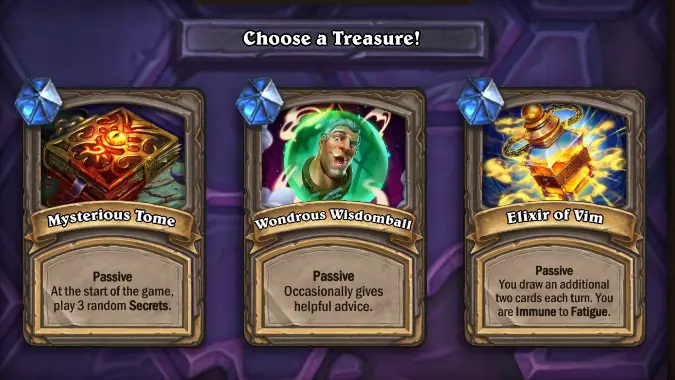
The treasures
Every few rounds, you’ll have the option to add a treasure to your deck. There are far too many to list individually, and many of them are situational. However, these favorites are almost always worth picking.
The best of the best
- Captured Flag (Passive): All of your minions get +1/+1. Unless your deck is almost all spells — and it probably won’t be — this is a fantastic buff that improves your damage output from the beginning of the game to the end of the game.
- Elixir of Vigor: Whenever you play a minion, shuffle two copies into your deck that cost 1 mana each. This lets you put minions on the board over and over again, and is particularly powerful with big minions, which you can play multiple times for a very low cost. As an added bonus, you’ll almost never run out of cards, which means sometimes you can simply outlast a boss.
- Hyperblaster (3): A 1/5 weapon with poisonous that makes your hero immune while attacking. Great for removing big minions you can’t kill any other way.
- Super Simian Sphere (5): Summon King Mukla, who’s immune and can’t be targeted by spells or hero powers. This is a 5/5 that’s immune to all damage, which gives you steady damage and good removal. Though there are a few ways to get rid of it, there aren’t many, and when you play it, it’s probably going to stick on the board for the rest of the game.
- Stargazing (Passive): You can use your Hero Power twice each turn and it costs 1 less. This is a big power boost to practically any deck, and is an even bigger boost to decks with Inspire cards, which you can trigger twice per turn.
- Wonderous Wisdomball (Passive): You may know the Wonderous Wisdomball from World of Warcraft, but if you don’t it’s essentially Khadgar’s floating head, following you around and making random commentary. The Wisdomball has a variety of effects — both good and bad — that trigger randomly. Sometimes it lets you draw extra cards, turns your minions into Legendaries, clears the board (which is sometimes good and sometimes bad), heals you for 20 health, or changes the mana cost of your cards (sometimes more and sometimes less). I find that Khadgar helps more often than he hurts, and when he helps, he helps in a big way.
These are really good, too!
- THE… Candles? (3): Deal 3 damage to all enemy minions, Twinspell, Twinspell, Twinspell. Yep, that’s three Twinspells, which amounts to a lot of AOE — particularly in a deck with any +spell damage.
- Emerald Goggles (Passive): The left-most card in your hand costs 2 less. While sometimes you’ll wind up with a card on the far left that you want to hold on to, this will often let you put down a lot of cards very quickly — and it’s even better when combined other mana reduction abilities. The only catch is that it can run you out of cards quickly, so it’s best paired with good card draw.
- Fly-By (5): Shuffle a Kaboom Bot into your opponent’s deck that explodes for 50 damage when drawn. Though you can’t play it until mid-game and who knows when it will trigger, it’s just so satisfying when it does.
- Recycling (Passive): Whenever a friendly minion dies, gain two armor. This is a decent addition to any deck, but it really shines in zoo and Deathrattle decks, where it lets you get even more value out of your minions.
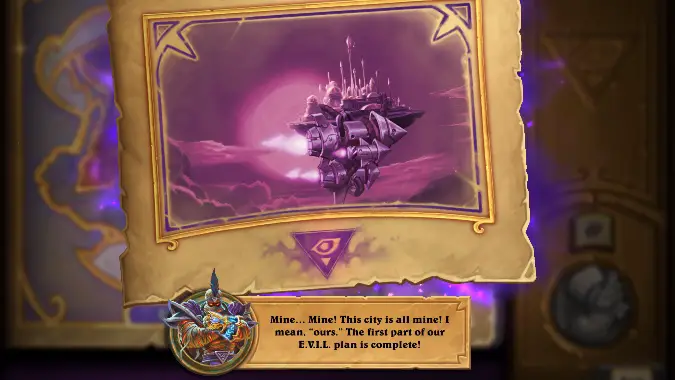
Your reward
Sure, there’s the fun of playing it, but we all know we’re here for the loot. Running through each wing of Rise of Shadows will net you three Rise of Shadows packs per wing, and finishing all five wings in Normal and in Heroic gave a unique card back.
But there’s one more to finishing the game: if you beat each chapter, you unlock Anomaly mode. With Anomaly mode, there’s another random effect that persists throughout each run — like Battlecries triggering twice or reducing the cost of your cards. Like all of the other randomness, it makes each game different — and encourages you to keep playing, even though by this point, you’ve run out of rewards.
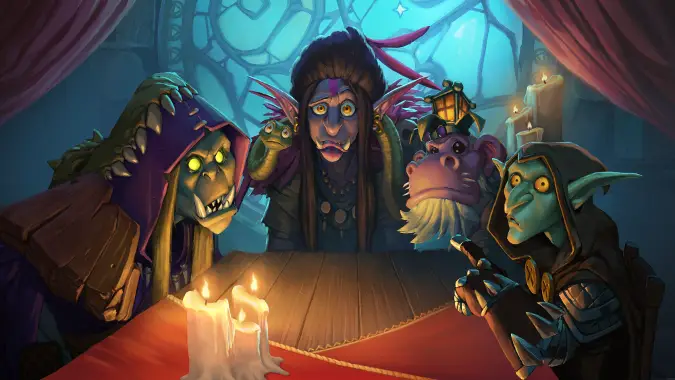
Good luck!
The one thing that assures victory in these RNG-driven Hearthstone single player adventures is persistence. So keep at it… and eventually you’ll land on the deck that will clear every boss.
Please consider supporting our Patreon!
Join the Discussion
Blizzard Watch is a safe space for all readers. By leaving comments on this site you agree to follow our commenting and community guidelines.
 @faience
@faience



